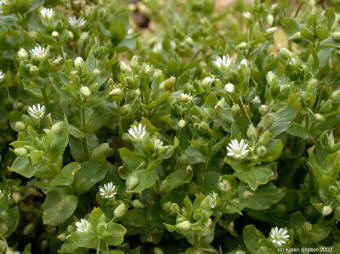Chickweed Herb

(c) Karen Bergeron
Stellaria media, Stellaria pubera
Other Names: Common Chickweeds, Star Chickweed, Mouse-ear Chickweed
Chickweed Herbal and Edible Uses
Chickweed is an easily found plant, often growing in yards from late Fall to Spring in the South and year round in the North. It has numerous historical uses as an herbal remedy.
Chickweed is very high in vitamins and minerals. It can be added to salads or sandwiches and cooked as a pot herb, tasting somewhat like spinach.
As a herb, Chickweed is probably best known as an old wives herbal remedy for weight loss. A recent study in mice shows that there may be some possible validity to that claim.
Anti obesity effect of Stellaria media against drug induced obesity in Swiss albino mice
Chickweed can be applied as a poultice on sore muscles or irritated skin, and relieves fragile, superficial veins or itching skin conditions. The infusion or juice of the plant is also used externally to treat rheumatic pains, wounds and ulcers.
An infusion of the Chickweed plant is used internally as a postpartum depurative, emmenagogue, galactogogue and circulatory tonic. Chickweed is also used to relieve constipation, and an infusion of the dried herb is used in coughs and hoarseness. It is also said to be beneficial in the treatment of kidney complaints. New research indicates Chickweed's likely use as an effective antihistamine.
Aside from occasional allergies, Chickweed is safe when used in moderation.
Excessive amounts may cause digestive disturbance.
Chickweed Habitat and Plant Description

Chickweed has long prostrate, often pinkish stems with a line of fine hairs on one side. The simple, oval leaves with pointed tips leaves are opposite on the stem and bright green. The five white petals are so deeply notched that they seem to grow in pairs, and the flower appears to have ten at first glance.
Chickweeds are an annual herb, widespread in temperate zones, arctic zones, and throughout, probable origin Eurasia. Chickweeds have established themselves all over the world, possibly carried on the clothes and shoes of explorers. They are as numerous in species as they are in region. Most are succulent and have white flowers, and all with practically the same edible and herbal values. They all exhibit a very interesting trait, (they sleep) termed the ’Sleep of Plants,’ every night the leaves fold over the tender buds and the new shoots.
Growing Chickweed
The cultivation of this Chickweed is not necessary it is abundant and easy to find. Gather above ground parts, before or as soon as flowers appear. It can be used fresh or dried for later herb use. Use the fresh, chopped herb to make tincture.
Chickweed Folklore and History
Old wives remedy for obesity, and used as a love charm.
Chickweed Recipes
Chickweed Herbal Tea: To 1 tbsp. dried herb, 2 if fresh, add 1 cup boiling water steep for 10 min. Take in 1/2 cup doses 2 to 4 times daily, during a cold or flu.
Add Chickweed leaves to salads as a fresh spring green.
Specialty Produce: Chickweed
More Information about Chickweed vegetable use
Chickweed Herbal Properties and Constituents
Chickweed is used in herbal medicine as an astringent, carminative, demulcent, diuretic, expectorant, laxative, refrigerant, vulnerary.
The major plant constituents in Chickweed are Ascorbic-acid, Beta-carotene, Calcium, Coumarins, Genistein, Gamma-linolenic-acid, Flavonoids, Hentriacontanol, Magnesium, Niacin, Oleic-acid, Potassium, Riboflavin, Rutin, Selenium, Triterpenoid saponins, Thiamine, and Zinc.
Article by Deb Jackson & Karen Bergeron



